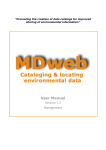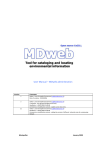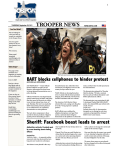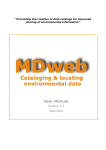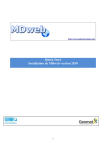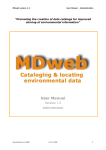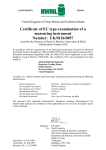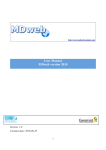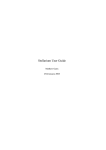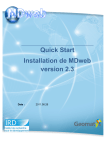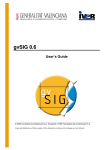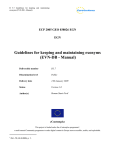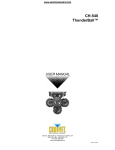Download User Manual – Managing metadata
Transcript
User manual - Managing metadata User Manual – Managing metadata Version Author : Jean Christophe Desconnets ([email protected]) Date of creation : 01/03/2006 12:37:00 2 Author: Jean Christophe Desconnets ([email protected]) Date of modification: unknown Comments: re-writing of document based on the prévious one of version 1.4 and updating document style for version 1.5 Translation : Kim Agrawal ([email protected]) Modified at : 01/07/2008 15:55:00 Comments on English version : english screen shot entry 2.1 1 Commentaires 1 Author: Jean Christophe Desconnets ([email protected]) Date of modification: 7/1/2008 3:55:00 PM Comments on English version : english screen shot entry for version 1.6 01/07/2008 User Manual – Managing metadata MDweb version 1.5 User Manual – Managing metadata BEFORE YOU START… ............................................................................... 4 CREATING YOUR USER ACCOUNT .............................................................. 4 OPENING A SESSION ................................................................................ 4 CREATING OR MODIFYING A METADATA SHEET ....................................... 7 IMPORTING OR EXPORTING A METADATA SHEET ................................... 24 ATTACHING DATA FILES TO A SHEET ...................................................... 29 ATTACHING A THUMBNAIL TO A METADATA SHEET ................................ 30 CREATING OR MODIFYING A CONTACT ................................................... 31 CREATING OR MODIFYING A SET OF PREDEFINED VALUES .................... 34 PROPOSING KEYWORDS ......................................................................... 35 User Manual – Managing metadata Before you start… This manual is meant for you, the MDweb user who needs to create metadata sheets. Since only authenticated users can create or modify sheets, you will have to request the organization running MDweb – via its administrator – to provide you with a user account and to assign a suitable role, with its associated rights, to you. Creating your user account You can obtain a user account with password by filing in the online registration form accessible via the Registration link on the home-page toolbar. When you submit the registration form, a confirmation e-mail will be sent to your e-mail address. Subsequently, the administrator will validate your registration by assigning you a role. As soon as he does so, you will receive an e-mail with your login name and password. Opening a session Once you have your login name and password, you can access the management module from the home-page toolbar. On clicking Ok, you may see this message: If you get this message, first verify that you entered your login name and password correctly. If the problem persists, verify that your browser accepts cookies: - In Internet Explorer, go to Tools/Internet Options/Privacy. Click the ‘Advanced’ button. In the ‘Advanced Privacy Settings’ dialogue box, enable the ‘Override automatic cookie handling’ checkbox and ‘Accept’ both first-party and third-party cookies. - In Firefox, cookies are enabled via the Tools/Options/Privacy/Cookies dialogue box. Check the ‘Allow sites to set cookies’ checkbox. MDweb version 1.5 User Manual – Managing metadata The management module provides access to a number of sub-modules and commands that allow you to add, modify and import metadata sheets. It also allows you to view metadata sheets that are confidential, i.e., those not accessible from the publicsearch module. Finally, you can manage your user account, contacts (personal contacts directory, used for synchronizing the contacts section of the standard) and predefined values by resource type (default values for data-entry forms). These features are accessible from the menu on the home page of the management module. User Manual – Managing metadata Managing your user account Go to Menu > Preferences > My account. You will be able to modify all the properties of your account except the role assigned to you by the administrator. You may want to change your password to one of your choosing. In addition, you can, if you like, also change the language as well as the default catalog. The default catalog is assigned to you by the administrator and is your working catalog. It will be displayed by default when you will add metadata sheets. MDweb version 1.5 User Manual – Managing metadata Creating or modifying a metadata sheet This section shows you how to add or modify a metadata sheet for different resource types to be referenced. It also provides details on how to synchronize metadata sheets (contact information) with the personal MDweb directory, synchronize predefined values, and attach data files and thumbnails. Adding a new reference to an MDweb catalog is a two-stage process: • Creating a metadata sheet in a catalog • Filling in information describing the referenced resource Auxiliary operations, such as modifying a sheet’s properties, the synchronization of contact information and predefined values, need not necessarily be executed when a new reference is added to the catalog; they can be run independently later. 1 – Creating a metadata sheet Depending on the type of metadata sheet you want to create, use the Menu > Create > Data collection or Menu > Create > Data set command. For Data collection, there are three types of resources that can be referenced in the standard MDweb version: • Temporal database • Geographic database • Digital map For Data set, the following resource types can be referenced in the standard MDweb version: • Paper map • Vector data • Satellite image, aerial photo • Data table • Text document Note: Procedures for creating a reference of either of the two types are identical. We will describe here the procedure to create a metadata sheet for a Data set resource type. User Manual – Managing metadata Description of the procedure for creating a sheet 1 – Go to Menu > Create > Data set. A form will be displayed for you to fill in. 2 – Choosing the title of the sheet: Enter a title in the corresponding field. This title need not necessarily be the title of the resource you are referencing; it is the title of reference within MDweb. The length of the title is limited to 80 characters. 3 – Choosing the catalog: If more than one catalog exists in your application, you will have to select the catalog in which your sheet will be stored. The drop-down list will allow you to choose one of the existing catalogs. 4 – Selecting the data type: You have to select the data type of the resource you are referencing. This is an important field; on the data type depends which form is displayed for you to fill in. In the standard version of MDweb, 8 data types are available. In this example, we will create a sheet to describe a ‘vector data’ data type. 5 – Selecting a data-entry level: A drop-down list will allow you to choose the level of detail you want to enter for your sheet. By default, the level is set to Basic. This level includes only those items essential for publishing a reference. 6 – Using an existing sheet to pre-fill the new sheet: Finally, you can, if you like, create your sheet with information already copied from another sheet of the same data type. Click on the Yes radio button and a list will appear: MDweb version 1.5 User Manual – Managing metadata You can select one of the sheets from the list to copy information from. When the sheet is created, all the contents of this source sheet will be copied to the new sheet. 7 – Validate by clicking Submit. The new metadata sheet will be created in the specified catalog. The first stage in the addition of a reference is now complete. Now the sheet will have to be filled-in and then validated so that it can be published and become accessible. a) ‘General information on your metadata sheet’ page Once you click Submit on the form for creating a metadata sheet, a page will appear with the title: General information on your metadata sheet. In this section, we will explore this page in detail, which: • lists the sheet’s properties, • allows synchronization of contacts and predefined values, • provides access to information-entry forms, • allows the attachment of data files, • allows the attachment of a thumbnail. User Manual - Managing metadata US –Desertification (IRD) 01/07/2008 10 MDweb version 1.5 User Manual – Managing metadata 2 – Entering information into the metadata sheet Information is entered into a metadata sheet via forms that consist of fields corresponding to the metadata standard used by your catalogue. There is a different form for each data type, i.e., one that consists of description fields chosen for the particular data type. a) Choosing the data-entry level By default, your metadata sheet’s data-entry level is the one you specified when it was created. If you want to change to a different entry level (Basic, Extended, Complete), select it in the Data-entry level drop-down list. Validate by clicking the Change button on the right of the list in your sheet’s properties box on the ‘General information’ page. b) Structure of the data-entry forms Each form corresponds to a section of the standard. For example, for the ‘vector data’ data type and the Basic data-entry level, three sections are offered: • The section for the identification of the data set • The section for the spatial representation of the data set • The section for the system of spatial reference At the Extended data-entry level, two additional forms will be accessible, corresponding to two more sections of the standard: • The section for the quality of the data set • The section for the distribution of the data set The sections Identification of the data set, Quality of the data set and Distribution of the data set are common to all data types available in the standard version of MDweb. For additional information on the ISO 19115 sections, refer to the ISO 19115 document: Geographic information – metadata ISO TC/211. 11 01/07/2008 User Manual –Managing metadata c) Accessing the forms To start entering information in a sheet, access the forms by clicking on the links in the frame on the left. 12 01/07/2008 User Manual – Managing metadata d) Data-entry environment The screen-shot below shows the data-entry environment. The frame on the left allows you to return to the General information page by clicking on the title of the sheet. You can go to entry forms of the other sections or, if you have arrived here for modifying a reference, return to the list of filtered sheets from which you chose this sheet to be modified. The central frame (in grey) displays the form. The form is organised in different sections with their titles in bold. The form’s fields are of several types. They are identified by a label. By clicking on the field label, you can access a glossary of the standard’s items. e) Different field types and their properties Different field types To make it easier for you to enter information and to improve consistency of the information entered, the forms consist of three types of fields: 01/07/2008 13 User Manual –Managing metadata • text fields for free text entry. The format and the length of the entered character string will be verified when the form is submitted. • drop-down lists whose items are taken from the standard. • Fields with assisted entry. These latter fields include date fields whose icon opens a calendar, keyword fields icon that opens a thesaurus, or the fields for specifying geographic with the icon that opens a cartographic interface. The next section extents using the explains these fields in greater detail. Properties Independent of its type, each field in the form has two properties that are set when the data-entry mask is defined. • The number of times several values for the presence of a + . Click minus icon - to reduce it occurs in the form, i.e., the possibility of entering field. The multi-occurrence of a field is shown by the the + to obtain another field of the same type. Use the the number of fields. • Whether the field is mandatory or not. If it is, a red asterisk * appears beside the field and you have to compulsorily fill it in before submitting the form. f) Assisted-entry fields Entering a date Date-entry fields should be in either YYYY or YYYY-MM-DD formats. To simplify the entering of dates and avoid formatting errors, the date fields are linked to a calendar that opens in a pop-up window when you click the icon. You can select the month and year using the calendar’s corresponding drop-down lists. The form closes when you click on the day; the selected date is sent to the date field. In our example, the date sent is 19-06-2007. Note: If you only want to enter a year, you have to type it manually in the YYYY format. Entering a keyword Keywords can be entered in two ways: • 14 By using the auto-complete feature of the field. As you type the first few letters of your keyword, MDweb suggests matching keywords from the thesauri associated with MDweb. These suggestions will be displayed below the keyword field. You can click on any of the suggested keyword to insert it into the keyword field. If your keyword is not included in the ones 01/07/2008 User Manual – Managing metadata offered, you can enter it into the keywords manager so that it is available in the future (see Creating or modifying a keyword). • • By using the pop-up thesaurus. If you cannot think of the keyword you want to use, you can select it from an Explorer-type window displaying thesauri entries in a tree structure. Click the 1 icon besides the keywords field to open this window. A menu allows you to choose which thesaurus to use2. Once a thesaurus is selected, use the auto-complete feature to select a term3 from which the thesaurus’s tree structure 01/07/2008 15 User Manual –Managing metadata will be displayed4. (In fact, since the reference thesauri are so large, it is not possible to display them in their entirety; only the application thesaurus can be displayed fully.) You can then navigate in the tree structure to see on the right5 the different relationships of a concept, then choose the concept if it is suitable 6. For more information, see the Note on thesaurus usage. Entering the geographic extent Notion of the geographic extent of a data set For a spatially localized data set (vector data, satellite image, map), the geographic extent is the spatial extent of the data. For example, if we are referencing the map of French départements1, the spatial extent to specify will be the national boundaries of France. For data sets that are not localized (text document, temporal database, data table, etc.), the geographic extent is the spatial extent to which the data relates. For example, if we want to reference a report on the integrated management of the Thau lake’s watershed, the spatial extent to be entered would be the Thau lake’s watershed. The geographic extent that you want to specify for your data set, or the bounding box, requires the entry of either the four East, West, North, South corners in decimal geographical coordinates or of the toponym. The geographic extent is essential for indexing your data set. It will be used during searches by location (Where? criteria) for your data set. Click on the icon and a pop-up window will open. A cartographic interface will display the active layers of the spatial reference base installed with your copy of MDweb. (The reference base is specific to each MDweb application.) Two features can be used to help enter the geographic extent: • The selection of an object (polygon, polyline or point) on the active layer and sending it to the form’s fields. • The definition of a bounding box using the mouse and sending it to the form’s fields. Example of entering the geographic extent using an existing geographic object In this first example, the user has an existing data set with the Hérault département as geographic extent. His geographic reference base contains an entity that is the outline of the Hérault département in the Départements layer. 1 A département is a French administrative region, analogous to a state or county in other countries. 16 01/07/2008 User Manual – Managing metadata Click the mouse button with the cursor hovering over the geometry, and the East, West, North and South coordinates will be inserted into the fields in decimal degrees as will the toponym of the corresponding entity into the relevant field. Example of entering the geographic extents using the bounding box In this second example, we assume that the user has a data set with a geographic extent that encompasses several départements. His geographic reference base does not have an entity corresponding exactly to the geographic extent of his data set. The user can use the mouse to draw a rectangle (drag-and-draw) corresponding approximately to his data set’s extent. When he lets go of the mouse button, the coordinates of the rectangle that he has drawn are sent to the form. 01/07/2008 17 User Manual –Managing metadata The toponym is generated automatically by the concatenation of the four coordinates. g) Submitting a form Before the information entered into a form can be saved during creation or modification of a sheet, you have to ensure that all mandatory fields, those marked with a red asterisk *, are filled in. (Remember that each form corresponds to one section of the standard) When you click the Submit button, the contents of the obligatory fields are checked and all the fields are checked for conformity with the respective field types. If any check fails, a dialogue box informs you of the problem. You can then correct the field in question and re-submit the form. 3 – Modifying a metadata sheet’s properties The properties box on the ‘General information on your metadata sheet’ page displays the properties of the sheet and allows you to modify some of them. Except the data type, the modification date, the name of the user who created the sheet, last update and the data-entry status, all other properties can be modified in an interactive manner. In this section, we briefly cover all the properties that can be modified. a) Title If you like, you can modify the title of your metadata sheet. The title can be a maximum of 80 characters long. To do so, modify the text in the Title of the sheet field and click the icon to save the new title. b) Catalog If you want to transfer the sheet to another local catalog, select it from the drop-down list of the Catalog field. Then click the icon to save your catalog selection. c) Data-entry level By default, the data-entry level of your metadata sheet is that specified when the sheet was created. If you want to change the data-entry level to a higher level, select the level you want (Basic, Extended, Complete) from the Dataentry level drop-down list and validate your choice by clicking the Change button on the right side of the list. Note: If you modify the data-entry level, certain sections of the standard may disappear (or appear) in the frame on the left to reflect the new level. 18 01/07/2008 User Manual – Managing metadata d) Publication status The publication status of a sheet corresponds to its accessibility during searches for references by the final user. Two statuses are possible: • Unvalidated, i.e., not published, shown by the • Validated, i.e., published, shown by the icon icon The modification of a sheet’s publication status is allowed if you have the rights to do so, i.e., if the administrator assigned you a validator’s role. Of course, the administrator himself can change this status. Click on the flag icon to toggle the publication status. With the sheet in the unvalidated state, the flag will appear red ; in the validated state it will be green . e) Confidentiality status The confidentiality status determines who can access a validated reference. Two statuses are possible: • The confidential status signifies that the sheet will only be accessible to authenticated MDweb users. • The non-confidential status signifies that the sheet will be accessible to anyone using the public search module. Click on the lock icon to toggle the confidentiality status. When set to confidential, the lock will be locked open ; when set to non-confidential, the lock will be displayed as . f) Synchronizing predefined values To simplify and automatize the entry of information on the data being referenced, two synchronization mechanisms are provided in MDweb. The first concerns the synchronization of default values. The purpose of this synchronization is to allow, during the creation of a sheet or before its validation, the automatic filling in of some fields whose values are constant for ‘technical’ 01/07/2008 19 User Manual –Managing metadata items, i.e., corresponding to the items of the standard for which specialized knowledge is necessary). For this, when a sheet is created, a predefined set of values is filled in. The user can modify them by going to Menu > Preferences > Manage values. These operations are covered in a different section in this manual (Creating or modifying a set of predefined values). To synchronize the predefined values into your sheet, the set of default predefined values default is available in the drop-down list. Click the Modify button to insert the values into your sheet. On the left of the drop-down list will be shown the date of synchronization of the values and the inserted set. g) Synchronizing the contact fields For the same reasons as for the synchronization of predefined values, the synchronization of the contact information allows the user to create a contact set in MDweb and to use it when creating or modifying a sheet. The synchronization of the contact information can be done independently for the three sections of the templates: • The section Identification of metadata • The section Identification of the data set • The section Distribution of the data set The Menu > Preferences > Manage contacts command allows the user to created and modify his contact set. To synchronize the contact information in your sheet with the contact sets defined earlier for each section, you can select a set and synchronize into your sheet by clicking the corresponding Insert button. On the left of the drop-down list will be displayed the date of the synchronization of the contact information inserted into the sheet. h) Attaching a thumbnail image 20 01/07/2008 User Manual – Managing metadata As contemplated in the ISO 19115 standard, it is possible to attach a thumbnail image of the referenced data to the sheet. The last item in the properties box allows the user to do so. This operation also fills in the corresponding item of the standard and stores the image on the hard drive of the MDweb server. A thumbnail can also be attached to an existing sheet using the Menu > Import/Export > Attach thumbnail command. This command allows batch attachment. Description of the procedure for attaching a thumbnail 1 – Click the Attach button to open the thumbnail attachment form. 2 – Selecting the file to attach: The form allows you to select an image file (jpeg, gif or png) containing the thumbnail of the metadata sheet that you want to import. Fill in the path and name of the file (or Browse to it) and the description field (optional) and Submit. The thumbnail will be attached to the new sheet. 3 – Validation: The name of the file will be shown in the properties box. i) Attaching data One or more data files can be attached to the metadata sheet from the Attach resource files to the sheet box. Currently, this box allows the user to load the files that he wants to attach to the sheet and compresses them into a zip archive. The loaded files are compressed on the fly in zip format and stored in MDweb’s resource folder on the web server with the identifier of the sheet to which the data is attached. Description of the procedure 1 – Loading the files to be attached: In the Attach resource files to the sheet box, a form allows you to load the data files from your local drive to the web server. Use the drop-down list to select the number of files to attach. 01/07/2008 21 User Manual –Managing metadata 2 – Attaching and zip compression: Fill in the path and name of the files (or Browse to them) and click Attach. 3 – Validating the operation: Depending on the size of the attached files, it may take some minutes for all the files to be compressed and stored. Once that is done, a box will appear on the page and display the names and sizes of the compressed files as well as the size of the zip archive and its creation date. Note: The total size of the files to be attached should not be bigger than your server’s storage capacity and should be suitable for the available bandwidth so that the operation does not exceed the timeout of your PHP module. If it does, the attachment operation will fail. 4- Modifying an existing metadata sheet The same page and operations described in the previous section (3- Modifying a metadata sheet’s properties) are used to modify an existing reference. Here we will show you how to search for a sheet and arrive at its general information page. Description of the procedure for modifying a sheet 1 – Go to Menu > Modify. You can search for a sheet to modify using five filtering criteria: - the catalog containing the sheet 22 01/07/2008 User Manual – Managing metadata - the data type - the sheet’s owner (if you are validator or administrator) - by date or title (sorting in ascending order) - the status of metadata sheet validation 2 – List of sheets: When you submit your criteria, the list of sheets that meet said criteria is displayed. You can see the main properties and modify some of them, notably the confidentiality and publication statuses. The icon allows you to delete a sheet. Note: If you do not specify any filtering criteria, all of your sheets will be displayed. Click the icon to go to the metadata sheet’s general information page. See sections 2Entering information into the metadata sheet and 3- Modifying a metadata sheet’s properties for details on modifying the sheet. 5 – Validating a metadata sheet for publication Validation is necessary for the publication of your metadata sheet and of its accessibility from the search module. It is something that should be done according to a procedure that has been discussed and consensually arrived at within the organization or team that is managing the catalog. Even though easy enough to execute – all one has to do is to toggle the red flag to green – a conscientious validation procedure should be put in place by the one or more persons having validators’ roles and who have been assigned this responsibility by the managing organization. The validation process should consider both the thematic and spatial descriptors that are used for indexation (in particular the keyword fields and the spatial extent) as well as the fields describing the contents of the data referenced (title, summary, for example). Accuracy of the information on the structural characteristics (type of representation, format, etc.) should also be checked. For these reasons, the validation should be entrusted to one or more persons who have thematic expertise on the referenced data and a good knowledge of geographic information specifications in general. Only with this background can a validator correctly evaluate the contents of the data and its technical specifications. 01/07/2008 23 User Manual –Managing metadata The validation operation itself can be executed from the sheet’s general information page (red flag > green flag ). The publication status of a sheet can only be changed if you have the rights to do so, i.e., if the administrator has assigned a validator’s role to you. Of course, the administrator himself can change this status too. Click on the flag icon to toggle the publication status. With the sheet in the unvalidated state, the flag will appear red ; in the validated state it will be green . Importing or exporting a metadata sheet 1- Importing metadata sheets One or more sheets can be imported using the Menu > Import/Export > Import XML command. In this MDweb version, you can import metadata sheets in XML format originating from three sources: - ArcCatalog 8.x, conforming to the ISO 19115 standard - GeoSource 1.0 or ArcCatalog 9.x conforming to the ISO 19139 standard (French profile) - End Notes Description of the procedure 1 – Go to Menu > Import/Export > Import XML. Select a source. A form will appear where you can specify the XML file(s) you want to import. To import more than one file (maximum 5) use the +1 and -1 buttons to increase/decrease the number of files. Use the Browse button(s) to navigate to the XML file(s) on your local drive. 2 – Submit and the XML files will be loaded. A summary table will show the details of the XML files and will also allow you to select the MDweb catalog into which each sheet will be imported. 24 01/07/2008 User Manual – Managing metadata In addition, you also have the opportunity to import a thumbnail and/or a zip archive to be attached to each sheet. (The Menu > Import > Attach thumbnails and Menu > Import > Attach data commands allow these operations to be executed for sheets that already exist in the catalogs.) If you want do so now, you can: 3 – Attaching a thumbnail: Click on the icon and a form will appear that will allow you to load a jpeg, gif or png file with the thumbnail image of the metadata sheet that you are importing. Fill in the path and name of the file (or Browse to it) and the description field (optional) and Submit. The thumbnail will be attached to the new sheet. 4 –Attaching a zip archive: Click on the icon and a form will appear that will allow you to load a compressed zip file containing the files of the resource described by the metadata sheet that you are importing. Fill in the path and name of the file (or Browse to it) and Submit. The zip archive will be attached to the new sheet. 5 – Validating the XML files to be imported: Once you have optionally attached the thumbnails and data files to the sheets to be imported, click Submit. The format of the XML files will be verified. 6 – Launching the XML import: Click on the Import button and the sheets will be inserted into the chosen catalog and the thumbnails and/or data files attached. 7 – Once the import operation is over, the screen above will be displayed. If you want, you can import more files by clicking the Import more XML sheets button. If a sheet already exists: If, while importing a sheet, MDweb finds that a sheet in a catalog is identical to the one being imported (same name and update date), you will have three options: 01/07/2008 25 User Manual –Managing metadata a) Skip: The file will not be imported. b) Update the sheet: The existing sheet will be updated by items from the sheet being imported. c) Create another sheet: The conflict will be ignored and a new sheet will be created in the catalog. 26 01/07/2008 User Manual – Managing metadata 2 – Exporting metadata sheets To allow the exchange of metadata sheets from MDweb to other cataloging tools, the export sub-module can export all metadata sheets which are complete at least to the Basic level. They are exported as XML files to: ArcCatalog 8.x (ISO 19115) or Geosource 1.0 or ArcCatalog 9.x (ISO 19139 French profile). One or more sheets can be exported using the Menu > Import/Export > Export XML command. Description of the procedure 1 – Go to Menu > Import/Export > Export XML. A form will allow you to select sheets to export based on clearly defined criteria. Four criteria can be used to filter sheets: a word in the title of the metadata sheet, the type of resource (vector theme, image, etc.), the catalog or the period in which the sheet was created or updated. 2 – Validate your criteria to get a list of corresponding sheets. Select the sheets you want to export by checking the boxes in the Export XML column. For reasons of performance, only a maximum of 5 sheets can be exported at one time. 3 – Launch the export by clicking the Export selected sheets button below the list. 01/07/2008 27 User Manual –Managing metadata 4 – Wait a few moments. Once the export operation is over, the displayed list is updated with the export date, the success of the export operation and the addition of a button in the Download column. This button can be used to download the exported sheets in XML format to one’s local drive. 5– By default, the created XML sheets are stored in MDweb’s xml/export folder on the web server. If you want to export additional sheets, repeat the process from step 3. Note: For sheets that have already been exported before, the script compares the export date with the last update date. Only if this latter date is later than the export date does the script export the sheet, otherwise it does nothing. Your MDweb server’s xml/export folder holds all the exported XML sheets. The sheets list generated by the export XML command provides an overview of the contents of the sheets already exported by displaying the sheet’s modification date and export date (‘Sheet title’ column). 28 01/07/2008 User Manual – Managing metadata Attaching data files to a sheet Attaching one or more data files to a metadata sheet is done using the Menu > Import/Export > Attach data command. You can access all your sheets from all the catalogs and attach data files to any of them. Once you select the files, MDweb will compress them on the fly into the zip format and store the zip archive in MDweb’s resource folder on your web server with the identifier of the sheet to which it is attached. Description of the procedure 1 - Go to Menu > Import/Export > Attach dataset. Three criteria allow you to filter the metadata sheets so that you can easily find the ones you want to use. These criteria are: - Origin of the sheet: Imported XML or from a local catalog, - Catalog which contains the sheet, - Data type that the sheet describes (vector data, satellite image, digital map, etc.). Click Submit to view the list of matching sheets. 2 – Selecting the metadata sheet: From the information displayed in the sheets list, you can easily see which sheets already have zip archives attached and the dates they were attached (Attached zip archive column). To attach one or more files, click on the Ok button in the Attach column. Caution: Attaching a data file to a metadata sheet automatically erases any archive already attached to that sheet. 3 – Selecting the files to attach: In the Attach file(s) of the data set to the sheet box, a form allows you to select files on your local drive for compression and storage on the web server. Use the drop-down list to choose the number of files you want to attach. 01/07/2008 29 User Manual –Managing metadata 4 – Compression of the data and attachment: Once you specify the file paths and names, click Attach. 5 – Verifying the operation: Depending on the size of the attached files, it may take some minutes for all the files to be compressed and stored. Once that is done, you will return to the sheets list you started out from. A message will inform you that the files have been saved in the zip archive. If you wish, you can now re-run the operation for other sheets. Note: The total size of the files to be attached should not be bigger than your server’s storage capacity (consult your system administrator, if necessary) and should be suitable for the available bandwidth so that the operation does not exceed the timeout of your PHP module. If it does, the attachment operation will fail. Attaching a thumbnail to a metadata sheet One or more thumbnails can be attached to a metadata sheet by the use of the Menu > Import/Export > Attach thumbnails command. You can access all your sheets from all the catalogs and attach a jpeg, gif or png file to each of them. The image file’s size should not exceed 100 KB. MDweb will store the thumbnail files in the images/thumb folder of MDweb and original image file in images folder. 30 01/07/2008 User Manual – Managing metadata Description of the procedure 1 – Go to Menu > Import/Export > Attach thumbnails. Three criteria allow you to filter the metadata sheets so that you can easily find the ones you want to use. These criteria are: - Origin of the sheet: Imported XML or from a local catalog, - Catalog which contains the sheet, - Resource type that the sheet describes (vector data, satellite image, digital map, etc.). Click Submit to view the list of matching sheets. 2 – Selecting the metadata sheet: From the information displayed in the sheets list, you can easily see whether a sheet already has a thumbnail attached and the date it was attached. To attach a thumbnail image, click on the Ok button in the Attach column. Caution: Attaching an image file to a metadata sheet automatically replaces any thumbnail image already attached to that sheet. 3 – Attaching the thumbnail and description: A new page displays a form that allows you to select an image file (jpeg, gif or png) for storage on the web server. Creating or modifying a contact Managing contacts: some concepts To minimize the work of entering information into metadata sheets, in particular information of a repetitive nature, MDweb allows you to specify information that you can load into different sheets easily. Information of this type includes contact information, representing the ISO 19115 standard’s contact information (CI_ResponsibleParty class). In fact, contact information is used in several sections of the standard, the main ones being Metadata identification, Data set identification and Data set distribution. Thus, MDweb allows you to create contact sets independent of metadata sheets and to manage these sets. When a new metadata sheet is created, you can use one of your contacts that already exists to fill in the appropriate fields in the sheet. You can choose a different contact set for each section. Manage your contact sets using the Menu > Preferences > Managing contacts command. 01/07/2008 31 User Manual –Managing metadata Description of the procedure to add or modify a contact 1 – Go to Menu > Preferences > Managing contacts > Add. The form that appears will allow you to add a contact. You will be required to enter a name for the contact. 2 – Creating a new contact from an existing one: The form allows you to create a new contact from an existing one. If you choose to do so, you will be asked to choose the existing contact from a list of existing contacts. 3. Choosing the default contact: The form allows you to define the new contact as the default contact for one or more sections of the standard. When a contact is made the default contact for a section, it will be offered by default in the properties box of your metadata sheet. You could thus synchronize your sheet without having to choose the contact from a list. In the example above, we have set our new contact as the default contact for the three sections used for information entry. 4 – Entering the contact information for a contact: After entering a name for the contact and optionally setting it as the default contact, click Submit to arrive at this entry form: 32 01/07/2008 User Manual – Managing metadata Fill in the fields of this form. Some fields are mandatory and are so marked *. When you submit the form, its contents will be saved. 5 – Modifying an existing contact: You can modify the information of an existing contact by using the Menu > Preferences > Managing contacts > Modify command. A list of your existing contacts will be displayed. You can Modify a contact by clicking on its icon. You can also delete a contact by using the icon, but only if it is not set as the default for any of the three sections of the standard. And, finally, from this list, you can change the contacts you want to use as the default thereafter for any of the sections. Note: In the current MDweb version, if a contact is modified or updated, the changed information is not reflected to those sheets with which this contact had been synchronized. To update the concerned sheets, you will have to re-synchronize them all with the updated contact. 01/07/2008 33 User Manual –Managing metadata Creating or modifying a set of predefined values Managing predefined values: some concepts For the same reasons as above, i.e., to minimize the work of entering information into metadata sheets, MDweb allows you to predefine values of some ‘technical’ items. Moreover, users who are not specialists in the standard will not get stumped when confronted by these fields. This feature allows these values to be masked from the user, notably those values that are unlikely to change from sheet to sheet, such as the metadata language (mdLang item) and the metadata character set (mdChar item). A set of predefined values is created for each user when the user account is created. The user can modify or delete it, and it can be checked and corrected by the administrator, who has access to the predefined values of all users. In the standard version of MDweb, the predefined-value sets cover very few items (less than 10). Certain template properties can, however, be modified to increase this number. Manage your sets of predefined values using the Menu > Preferences > Manage values command. Description of the procedure to add or modify predefined values 1 – Go to Menu > Preferences > Manage values > Add. The form that appears will allow you to add a set of predefined values. You have to first enter a name for the set of predefined values and then choose the data type to which it will apply. 2 – Creating a new set from an existing one: The form allows you to create a new set of values from an existing one. If you choose to do so, you will be asked to choose a set from a list of existing sets of values of the same data type. 3. Choosing the default contact: The form allows you to define the new set of values as the default set. When a set is made the default set, it will be offered by default in the properties box of your metadata sheet. You could thus synchronize your sheet without having to choose a set of values from a list. 4 – Entering the predefined values: After entering the name and optionally making the set the default set, click on the Submit button to get to the entry screen. The entry screen consists of three tabs corresponding to the sections of the standard; you have to enter your values here. 34 01/07/2008 User Manual – Managing metadata The entry or modification of values and their submission is done tab by tab. Before going from one tab to another after entering/modifying values, you have to click the Submit button to save the changes. 5 – Modifying an existing set of values: You can modify values of an existing set by using the Menu > Preferences > Manage values > Modify command. The list of your sets of values will be displayed. You can Modify a set by clicking on its icon. You can also delete a set by using the icon, but only if it is not set as a default. And, finally, from this list, you can change the default setting for each set. Note: The sets of predefined values are unlikely to change very often. However, in case you want to reference data with different sets of predefined values (different language or character set, for example), you can create several sets of values for the same data type. Proposing keywords 01/07/2008 35 User Manual –Managing metadata Managing keywords: some concepts When a word is entered into a keyword field in the entry forms and if it is not already part of thesaurus, MDweb provides the option of adding it to its keywords database. This feature is an alternative to the use of the GCMD thesaurus to control keyword entry in the current version. These ‘free’ keywords are stored and linked to the user who entered them. The Managing your keywords section shows how you can manage them, for example, to correct a spelling, to attach it to a category, or to delete one or more of them. The MDweb administrator has, of course, access to all keywords of all users and can modify them to ensure consistency amongst them. Keywords can be managed using the Menu > Preferences > Manage keywords command. 36 01/07/2008 User Manual - Managing metadata The keywords manager 01/07/2008 37 Description of the procedure to add or modify a keyword 1 – Go to Menu > Preferences > Manage keywords. The keywords manager screen will appear. 2 – Adding a term: In the frame on the left, you can enter a new term. You have to assign the new term to a category using the drop-down list. Click Submit to add the term to your keywords list. 2 – Modifying or deleting a term: Your list of keywords is displayed on the right. If you have many keywords, you can filter them using the alphabetic index. To Modify a keyword, click on the icon. To delete one, click on the icon. 3 – Modifying a term: A term is modified in the same way as a new one is added. Click on the Modify button for the modified keyword to be saved. User Manual – Managing metadata Note: In the current MDweb version, the modification of a term is not automatically transmitted to the sheets already using that term as a keyword. Contacts IRD / ESPACE unit (US 140) 500, rue Jean François Breton, 34093 Montpellier Cedex 05, France TEL : +33 (0)4 67 54 87 02 J.C Desconnets [email protected] MDweb project site: www.mdweb-project.org Online demo: demo16.mdweb-project.org/ 01/07/2008 39







































